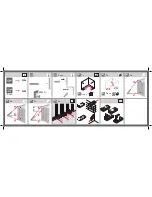
Type H.30
o
&S? a** '^sgi a m
^
Ira*
ii
-vki.v
M i ’ fe ' va w
f: P \ fi? @*n?a f*> %
f? jf *P *e$!a H /^:S>. .P* B t f * '
M
m \ i *& r is
£('xSk,
%sf M
u y*8&S
id! « v
Change information, if any, affecting this section will be found at the
rear of the manual.
Introduction
A Spectrum Analyzer is an instrument that graphically
presents a plot or relative power distribution as a function
of frequency for a selected portion of the spectrum. The Type
1L30 is designed to provide a spectral display of frequency
distribution of electromagnetic energy within the frequency
range of 925 M H z to 10,500 M Hz. This display provides the
following information: the presence or absence of signals
within a frequency spectrum, their frequencies, frequency
drift, relative amplitude of the signals and the nature of
moduation if any, and many other characteristics.
This section of the manual covers the following: A glossary
of terms; a description and function of the front panel con
trols and connectors; a first time operational procedure, and
some basic application with signal evaluation.
Installation
The Type 1L30 is designed to operate in any Tektronix
oscilloscope accepting letter- or 1-series plug-in units.
It
may also be used with a Tektronix Type 132 or 133 Plug-In
Power Supply, with the output displayed on the CRT of
any oscilloscope that has a 100 or 150 volt sweep output
available.
'
If the Type 1L30 Spectrum Analyzer is to be used with the
Tektronix Type 541, 541 A, 543, 543A, 545 or 545A Oscillo
scope, a modification is required to the plug-in oscilloscope
to correct undesirable display distortion and dispersion non
linearity. This distortion is caused by a part of the vertical
output signal from the Vertical Signal Out C. F. V1223A
(V1050B, Type 545), feeding into the Spectrum Analyzer on
the + 2 2 5 V supply. The distortion appears as a change of
dispersion linearity with a change of the analyzer G A IN
control setting and is most noticeable in the narrow dis
persion settings such as 1 kHz/cm. It also appears as a non-
symmetrical response to a C W signal in which the slope of
one side of the signal drops abruptly to the base line. See
Fig. 2-1.
Change the + 2 2 5 volt supply for the Vertical Signal Out
C.F. (V1223A cathode resistor) from the junction of R1008
and R1007 (R1153 and R1152, Type 545) or + 2 2 5 V (DEC)
and connect it to the other side of R1088 (R1153, Type 545)
which is the + 2 2 5 V supply. See Fig. 2-2.
Spectrum Analyzer Terms
The following glossary of spectrum analyzer terms is
presented as an aid to understanding the terms as they are
used in this manual.
©
1
t
11
( f i
/
V
(A)
N
ormal respoiwe to a cw signal
J r
(B)
E
feet of dista rtion >n a cw sigr al.
Fig. 2-1. (A) Normal response to a cw signal. (B) Effect of dis
tortion on a cw signal.
Spectrum Analyzer— A device that displays a graph of
the relative power distribution as a function of frequency,
typically on a cathode-ray tube or chart recorder.
Types: Real-time and non real-time.
A real-time spectrum-analyzer performs a continuous an
alysis of the incoming signal, with the time sequence of
events preserved between input ond output.
A non-real-time spectrum analyzer performs an analysis of
a repetitive event by a sampling process.
Methods: Swept front end and swept intermediate fre
quency.
A swept front end spectrum analyzer is a superheterodyne
spectrum analyzer in which the first local oscillator is swept.
A swept IF spectrum analyzer is a superheterodyne spec
trum analyzer in which a local oscillator other than the first
is swept.
Center frequency (radio frequency or intermediate fre
quency)— That frequency which corresponds to the center of
the reference coordinate.
Center frequency range (radio frequency)— That range
of frequencies which can be displayed at the center of the
r
rtfr-V'
f:
T
if-
Srj;
2-1
Summary of Contents for 1L30
Page 48: ...si L i y n Maintenance Type 1L30 Fig 4 15 Honeycomb assembly drcui a n d component layout 4 n ...
Page 59: ...Fig 6 1 A Test equipment required for calibration ...
Page 60: ... Calibration Type 1130 ...
Page 120: ...T Y P E I L 3 0 S P E C T R U M A N A L Y Z E R ib i IF SYSTEM BLOCK DIAGRAM 9 1 9 2 ...
Page 127: ......








































